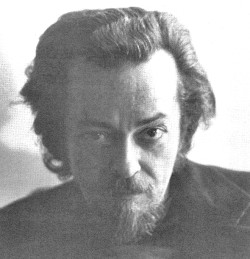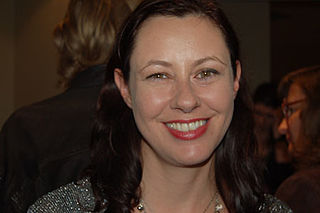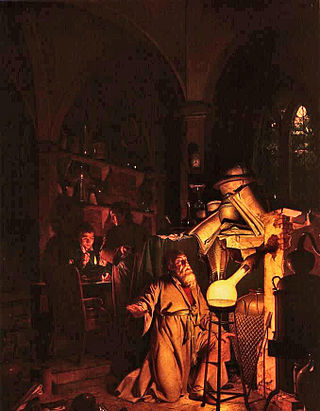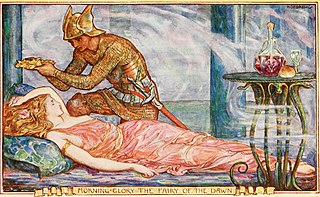Related Research Articles

A fairy tale is a short story that belongs to the folklore genre. Such stories typically feature magic, enchantments, and mythical or fanciful beings. In most cultures, there is no clear line separating myth from folk or fairy tale; all these together form the literature of preliterate societies. Fairy tales may be distinguished from other folk narratives such as legends and explicit moral tales, including beast fables. Prevalent elements include dwarfs, dragons, elves, fairies, giants, gnomes, goblins, griffins, mermaids, talking animals, trolls, unicorns, monsters, witches, wizards, and magic and enchantments.

Speculative fiction is an umbrella category of fiction that, in its broadest sense, encompasses all the genres that depart from realism, or imitating ordinary reality, such as in the context of supernatural, futuristic, and other imaginative realms. This catch-all genre thus includes, but is not limited to, science fiction, fantasy, horror, superhero fiction, alternate history, utopian and dystopian fiction, and supernatural fiction, as well as combinations thereof. The term has been used with a variety of meanings for works of literature.

Linwood Vrooman Carter was an American author of science fiction and fantasy, as well as an editor, poet and critic. He usually wrote as Lin Carter; known pseudonyms include H. P. Lowcraft and Grail Undwin. He is best known for his work in the 1970s as editor of the Ballantine Adult Fantasy series, which introduced readers to many overlooked classics of the fantasy genre.
Charles de Lint is a Canadian writer of Dutch, Spanish, and Japanese ancestry. He is married to, and plays music with, MaryAnn Harris.
Urban fantasy is a subgenre of fantasy, placing supernatural elements in an approximation of a contemporary urban setting. The combination provides the writer with quixotic plot-drivers, unusual character traits, and a platform for classic fantasy tropes, without demanding the creation of an entirely-imagined world.

Historical fantasy is a category of fantasy and genre of historical fiction that incorporates fantastic elements into a more "realistic" narrative. There is much crossover with other subgenres of fantasy; those classed as Arthurian, Celtic, or Dark Ages could just as easily be placed in historical fantasy. Stories fitting this classification generally take place prior to the 20th century.

Fantasy literature is literature set in an imaginary universe, often but not always without any locations, events, or people from the real world. Magic, the supernatural and magical creatures are common in many of these imaginary worlds. Fantasy literature may be directed at both children and adults.

Terri Windling is an American editor, artist, essayist, and the author of books for both children and adults. She has won nine World Fantasy Awards, the Mythopoeic Fantasy Award, and the Bram Stoker Award, and her collection The Armless Maiden appeared on the short-list for the James Tiptree, Jr. Award.

Caroline Stevermer is an American writer of young adult fantasy novels and shorter works. She is best known for historical fantasy novels.

Elements of the supernatural and the fantastic were an element of literature from its beginning. The modern genre is distinguished from tales and folklore which contain fantastic elements, first by the acknowledged fictitious nature of the work, and second by the naming of an author. Works in which the marvels were not necessarily believed, or only half-believed, such as the European romances of chivalry and the tales of the Arabian Nights, slowly evolved into works with such traits. Authors like George MacDonald (1824–1905) created the first explicitly fantastic works.
Fairytale fantasy is distinguished from other subgenres of fantasy by the works' heavy use of motifs, and often plots, from folklore.
Midori Snyder is an American writer of fantasy, mythic fiction, and nonfiction on myth and folklore. She has published eight novels for children and adults, winning the Mythopoeic Award for The Innamorati. Her work has been translated into French, Dutch, Italian and Turkish.

The Wood Wife is a novel by American writer Terri Windling, published by Tor Books in 1996. It won the Mythopoeic Award for Novel of the Year. It is Windling's first novel; she is better known as a longtime editor of fantasy and speculative fiction. Set in the mountain outskirts of contemporary Tucson, Arizona, the novel could equally be described as magical realism, contemporary fantasy, or mythic fiction. Windling draws on myth, folklore, poetry, and the history of surrealist art to tell the story of a woman who finds her muse in a spirited desert landscape. The plot revolves around a reclusive English poet, Davis Cooper, and his lover, Mexican surrealist painter Anna Naverra—a character reminiscent of the real-life Mexican painter Remedios Varo.

Kate Forsyth is an Australian author. She is best known for her historical novel Bitter Greens, which interweaves a retelling of the Rapunzel fairy tale with the true life story of the woman who first told the tale, the 17th century French writer Charlotte-Rose de Caumont de La Force.

Elements of the supernatural and the fantastic were an element of literature from its beginning, though the idea of a distinct genre, in the modern sense, is less than two centuries old.

Fantasy is a genre of speculative fiction involving magical elements, typically set in a fictional universe and usually inspired by mythology or folklore. The term "fantasy" can also be used to describe a "work of this genre", usually literary.

Urban Gothic is a subgenre of Gothic fiction, film horror and television dealing with industrial and post-industrial urban society. It was pioneered in the mid-19th century in Britain, Ireland and the United States and developed in British novels such as Robert Louis Stevenson's Strange Case of Dr Jekyll and Mr Hyde (1886), and Irish novels such as Oscar Wilde's The Picture of Dorian Gray (1890), and Bram Stoker's Dracula (1897). In the twentieth century, urban Gothic influenced the creation of the subgenres of Southern Gothic and suburban Gothic. From the 1980s, interest in the urban Gothic revived with books like Anne Rice's Vampire Chronicles and a number of graphic novels that drew on dark city landscapes, leading to adaptations in film including Batman (1989), The Crow (1994) and From Hell (2001), as well as influencing films like Seven (1995).

The following outline is provided as an overview of and topical guide to fantasy:
References
- ↑ "A Mythic Fiction Reading List", The Journal of Mythic Arts
- ↑ Julie Bartel, The Continuum Encyclopedia of Young Adult Literature, "Mythic Fiction for Yong Adults," The Continuum International Publishing Group, Inc., 2005.
- ↑ Julie Bartel, The Continuum Encyclopedia of Young Adult Literature, "Mythic Fiction for Yong Adults," The Continuum International Publishing Group, Inc., 2005.
- ↑ Dirda, Michael. "A book-length historical fantasy about a crow? It's not as birdbrained as that sounds". Washington Post. Retrieved 2019-09-10.